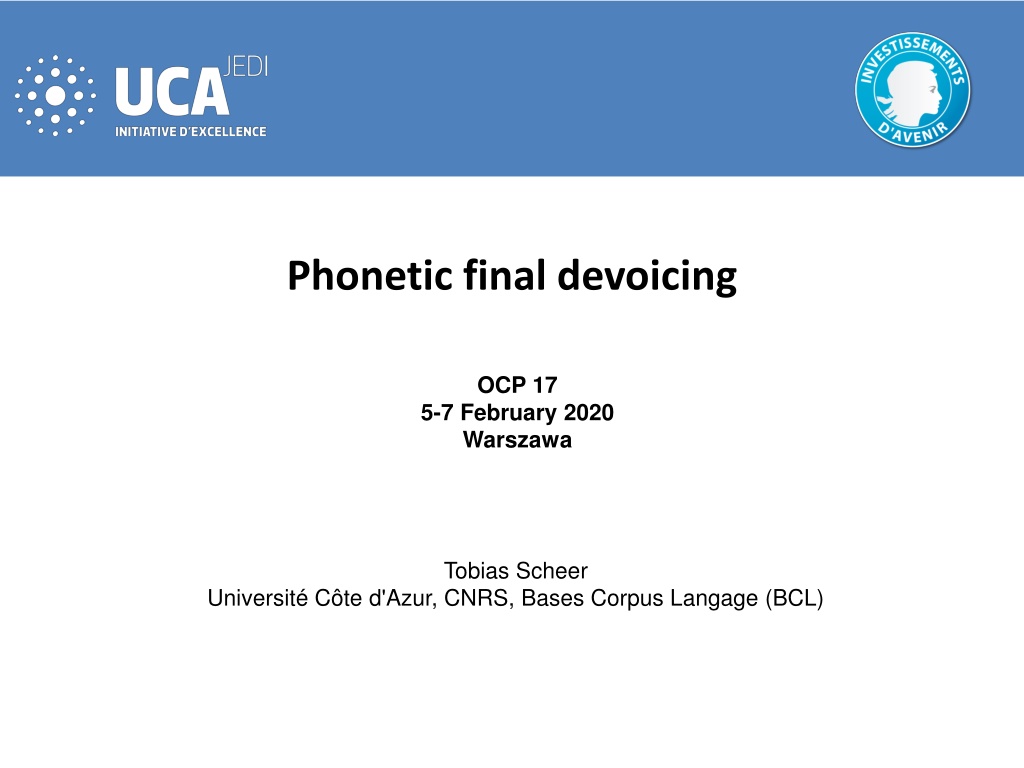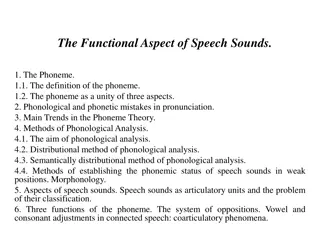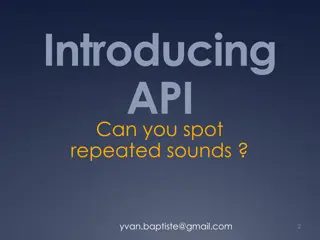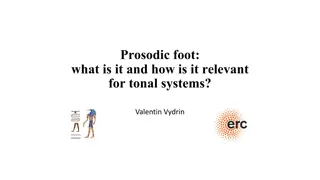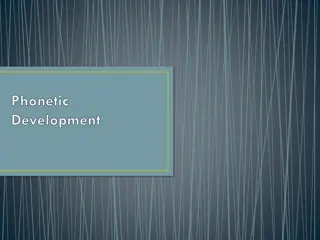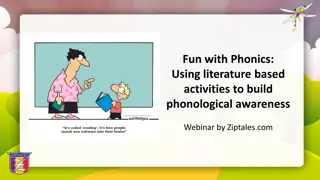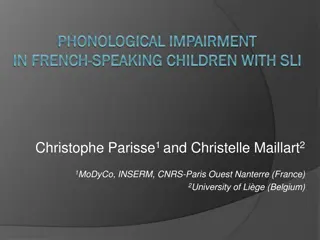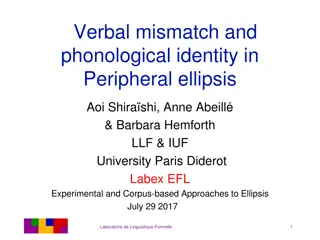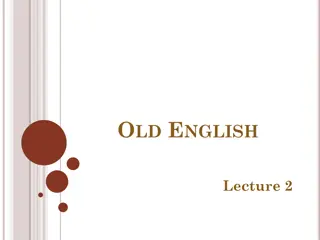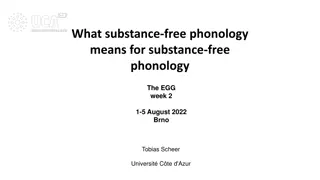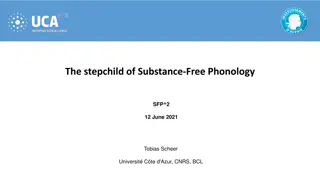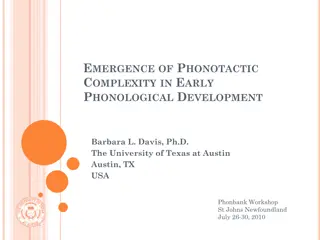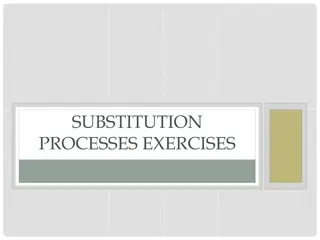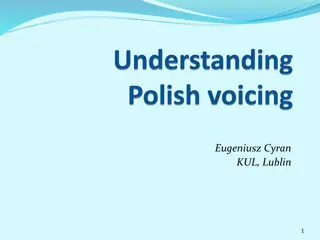Understanding Phonetic Final Devoicing and Its Implications in Phonological Theory
Phonetic Final Obstruent Devoicing (FOD) challenges traditional phonological theories by presenting instances where devoicing cannot be purely phonological but must be phonetic in nature. This phenomena is evident in Proto- and Old French where word-final consonants devoice despite having intervocalic status in phonology. The debate on whether FOD represents strengthening or weakening in phonological processes continues, with ongoing discussions around the too-many-solutions problem in Optimality Theory. Additionally, incomplete devoicing in languages like German further highlights the complexities of this phenomenon.
Download Presentation

Please find below an Image/Link to download the presentation.
The content on the website is provided AS IS for your information and personal use only. It may not be sold, licensed, or shared on other websites without obtaining consent from the author. Download presentation by click this link. If you encounter any issues during the download, it is possible that the publisher has removed the file from their server.
E N D
Presentation Transcript
Phonetic final devoicing OCP 17 5-7 February 2020 Warszawa Tobias Scheer Universit C te d'Azur, CNRS, Bases Corpus Langage (BCL)
purpose Since structuralism, Final Obstruent Devoicing (FOD) is held to be phonological in kind. FOD is a notorious troublemaker in phonological theory. Phonetic FOD a case is presented where FOD cannot possibly be phonological and hence must be phonetic. argument: in the language in question, Proto- and Old French, word- final consonants have intervocalic status in the phonology. But they still devoice (while true intervocalic consonants of course do not). the only place where they are final of anything is in the phonetics. Conclusion there is purely phonetic FOD this implies that language-specific phonetics can see morpho-syntactic divisions. phonological FOD is the result of the phonologization of a phonetic precursor.
FOD is a notorious troublemaker Coda strengthening ?! devoicing is strengthening since voiceless obstruents are less sonorous than voiced obstruents. intervocalic voicing the other typical lenition environment, the intervocalic position, does indeed produce regular lenition, i.e. voicing. the coda is lenition-promoting ==> how could strengthening occur in a lenition context? ongoing debate FOD is strengthening for the reasons mentioned: Iverson & Salmons (2007, 2011) FOD is weakening because a prime is lost: Kiparsky (2006), Harris (2009)
FOD is a notorious troublemaker The too-many-solutions-problem in OT a prominent instantiation: FOD Blumenfeld (2005, 2006: 21), Staroverov (2010) etc. Steriade (2009) "The Too-Many-Solutions conundrum arises when the system of constraints and rankings predicts too many resolutions of a given phonotactic problem. [ ] [I]f phonologies aim to eliminate final voiced obstruents, why don t they employ obstruent nasalization, deletion, metathesis?" p.154 "[D]evoicing is the only available cure for violations of (1)" = *[+VOICE]/__] " p.153 "My claim is not that nasalization, C-deletion, and so forth are unattested processes, but that they are unattested as responses to the voicing problem posed by (1). This means that one does not encounter sound systems in which all the final voiced stops, and only those stops, turn to nasals, delete, or trigger epenthesis or metathesis. " p. 152
FOD is a notorious troublemaker Incomplete devoicing FOD was shown to be incomplete both in the acoustic signal: in German, underlyingly voiced final Cs are about 15 ms longer than underlyingly voiceless Cs (Port & O'Dell 1985). and in perception: German natives correctly discriminate a "minimal" pair (Rat vs. Rad) at a rate of 60-70%. relevant literature: Port & Crawford (1989), van Oostendorp (2008)
FOD is a notorious troublemaker Incomplete devoicing how could a phonologically neutralized distinction be visible in the phonetics? if FOD is phonological, underlyingly voiced and voiceless consonants are identical when phonological computation is completed. hence the underlying difference should be unrecoverable in the phonetics. if FOD is phonetic in kind, this problem disappears: nothing happens in the phonology and phonetics receives two distinct objects. gradience indicates that the process causing FOD is phonetic, not phonological.
FOD is a notorious troublemaker FOD is the only coda process that applies to final, but not to internal codas. coda asymmetry coda effects may concern both internal and final codas internal, but not final codas deaspiration velarisation s-debuccalisation liquid gliding depalatalisation l-vocalisation r-vocalisation/ loss Ch C l,n , s h r,l j n w r but there is no case on record where final codas but no internal codas produce an effect. this is true for effects on the coda itself on the vowel preceding the coda coda effect triggered by internal coda + + final coda + + l-vocalization in Braz. Port. l-vocalization in Old French trivial not on record C t (2011), Scheer (2004: 536), S g ral & Scheer (2008: 146f)
Proto- and Old French: evidence #1 Evolution from Latin to Old French NB: only labials and dentals are considered. Velars show the same behaviour, but their situation is greatly complicated by additional palatalization. internal coda = __.C labials > zero primary cluster Old Fr. Mod. Fr. route chasse ch sse b subtus soz obst re oster f w secondary cluster Old Fr. tiede mausade code doter Etienne antiene nagier cit Lat Lat tep(i)du male-sap(i)du cub(i)tu dub(i)t re Steph(a)nu antiph(o)na n v(i)g re c v(i)t te Mod. Fr. ti de maussade coude douter p rupta capsa sous ter antienne nager
Proto- and Old French: evidence #1 Evolution from Latin to Old French internal coda = __.C dentals > zero primary cluster Old Fr. secondary cluster Old Fr. rolle Lat Mod. Fr. Lat rot(u)lu frk Hrotland Rolland spat(u)la rad( )c na j d(i)c re med(i)c na med(i)c re mod(u)lu Mod. Fr. r le Roland paule t espalle racine jugier mecine megier molle d adven re advoc re adsatis adm r r avenir avoer assez amirer advenir avouer juger m decine donner soin (le) moule admirer Note: there is also a type t(v)l > kl > jl vet(u)lu > veclu > vieil, but this evolution is pan-Romance and thus occurred in Late Latin.
Proto- and Old French: evidence #1 Evolution from Latin to Old French intervocalic position = V__V labials > v Lat p r pa capistru b faba d b re Old Fr. rive chevestre chev tre feve deveir Mod. Fr. Lat lav re lev re raphanu Stephanu Estievene Old Fr. laver lever ravene Mod. Fr. w f ve devoir f radis Etienne dentals > OFr. > OFr. > zero Lat t vita spatha Catomagu catuno m nstr ta Old Fr. vide espede Ca un cadhuna mustrethe Old Fr. vie espee Mod. Fr. vie p e Caen chacun montr e Lat Old Fr. Old Fr. Mod. Fr. lauder loer aie audir oir d laud re d r. adj t re aide aud re louer aide ou r
Proto- and Old French: evidence #1 summary thus far internal coda intervocalic v v v v p b f w > > > > t d > > > > NB: sonorants are unexploitable because they produce the same result in internal coda and intervocalic position (= stable).
Proto- and Old French: evidence #1 word-final consonants: primary (= already word-final in Latin) inflectional morphemes -t, -d > - Lat 3sg pr s. Old Fr. 3sg pr s. Lat d nat scr b(i)s d b( )t cant bat cant vit d net Old Fr. donet escri-t dei-t chantevet chantat donet Mod. Fr. donne crit doit chantait chanta donne 3sg imparf. 3sg parf. 3sg subj. 3sg imparf. 3sg pass. simple 3sg subj. in function words (there are no C-final content words) -t, -d > - Lat Old Fr. t et ed, et subj. 3sg sit seit d quid (tonique) queit quid (atone) qued, quet apud od ad ad, at quod qued Old Fr. e Mod. Fr. et soit quoi que "avec" que quei, coi que o que
Proto- and Old French: evidence #1 word-final consonants: secondary (= intervocalic in Latin) V__(V)# Lat ap(e) trab(e) bov(e) sit(i) n d(u) Old Fr. ef tref buef seid nout, Old Fr. Mod. Fr. abeille poutre b uf soif n ud p b w t d > f > f > f > > sei neu
Proto- and Old French: evidence #1 the vowel preceding word-final consonants is in an open syllable tonic vowels in open syllables diphthongize tonic vowels in closed syllables do not systematic diphthongization before primary C# Lat t subj. 3sg sit d quid (tonique) k apud hoc illoc sine hoc pro hoc m rem tom r cor p r l mel fel s l s tr s tra(n)s Old Fr. seit queit avuec iluec, luec senuec poruec, pruec rien tuen, tien cuer per miel fiel sel treis tres Mod. Fr. soit quoi avec "l " "sans cela" " cause de cela" tien c ur (de) pair trois tr s
Proto- and Old French: evidence #1 general summary internal coda intervoc. C# prim. sec. f preceding V is in open syll. is in open syll. lab dent > > v C# patterns with intervocalic, not with coda consonants: it produces the voiceless version of the intervocalic result. note that it cannot be argued that the intervocalic behaviour of C# is due to extrasyllabicity: being extrasyllabic is being syllabically nothing. But here C# is positively intervocalic. ==> difference between "being a non-coda (=extrasyllabic)" and "being intervocalic". the preceding vowel is always in an open syllable.
Proto- and Old French: evidence #2 loss of V V and - # in Early Old French - # and V V lost in the East and North-East from the end of the 9th century on, but is still systematically present in the Alexis, i.e. 11th century Normandy loss is complete by the 12th century, e.g. in Roland. same diatopic pattern same texts same chronology Dating of the loss of - #: Fouch (1952-61 : 658), Nyrop (1903 : 53), Pope (1934 : 346 sq.), Bourciez & Bourciez (1967 : 151-H, Rq2), Straka (1979 [1964] : 248), Picoche & Marchello-Nizia (1999 : 212). V V: Pope (1934 : 347), Meyer-L bke (1908 : 194), Fouch (1952-61 : 600), Bourciez & Bourciez (1967 : 142-H), Nyrop (1914 : 394), Regula (1955 : 112).
Proto- and Old French overall summary V__V = V__# FOD and V__V = V__# exist in the same language / diachronic stage Old French has FOD (masc. froit, fem. froid-e etc.) we don't know about Proto-French V__V = V__# is necessarily contemporaneous with FOD since - # and V V were lost during Old French. ==> in Old French, FOD applies to a phonologically intervocalic consonant.
Proto- and Old French FOD is phonetic -C# is phonologically intervocalic how can an intervocalic consonant undergo FOD? of course "real" intervocalic obstruents in V__V do not voice. final devoicing of phonologically intervocalic consonants makes no sense: if anything, intervocalic consonants undergo voicing, not devoicing.
Proto- and Old French FOD is phonetic FOD in Old French is not phonological in kind. it applies in the phonetics, i.e. after the completion of phonological computation where nothing happens to final obstruents. final obstruents contrast in the phonology and are handed down to the phonetics as distinct items. note that this requires that phonetics can "see" morpho-syntactic divisions. This is a debated question: Berm dez-Otero & Trousdale (2012), Strycharczuk & Scobbie (2016), Jatteau et al. (2019).
phonological status of C# zoom out: FOD in phonological theory what are -C#s that do not behave as codas? ==> all theories say: "a non-coda". but if C# is a non-coda, what exactly is it, syllabically speaking? solution #1: C# is extrasyllabic C# is a non-coda, but also a non-onset: syllabically it is nothing. solution #2: C# is the onset of a final empty nucleus Government Phonology (Kaye 1990, Piggott 1999, Gussmann & Harris 2002, Cyran 2014), but also elsewhere: Dell (1995), Burzio (1994), Kiparsky (1991), van Oostendorp (2005). if they are onsets, what kind of onset are they? strong position (word-initial, post-coda)? intervocalic?
phonological status of C# C# is a final non-coda the literature does not contain any evidence or argument allowing us to determine the precise phonological identity of word-final non- codas. in Old French final non-codas are positively intervocalic. this is parallel to the other edge of the word: #C- may be strong or non- strong. If non-strong it is phonologically intervocalic (evolution of s in Classical Greek).
phonological FOD there are cases where FOD interacts with phonological processes. in these cases it must be phonological in kind. High Prussian (K hnlein 2018) opaque interaction with the plural marker (whatever it is: a protective schwa or, in K hnlein's analysis, a template enforcing -C# to be the onset of an empty nucleus). sg pl taag brood kerv g taak d broot p korp "day" "bread" "basket" van Oostendorp (2008: 1364) mentions other cases, not all convincing.
phonological FOD Cyran (2014: 48-50): FOD in two dialects of Polish, one being an aspiration, the other a voice language. Warsaw voicing language: CL vs. C phonology: FOD removes L : CL C / __# lexical C remains unmodified spell-out (interpretation): C [voiceless] in all contexts no passive voicing in the language abLa - ab map a - map
phonological FOD Krak w-Pozna aspiration language: CH vs. C phonology: FOD removes H : CH C / __# lexical C remains unmodified phonetics: C [voiced] / __V C [voiceless] / __# mapHa - map ab a - ab passive voicing no passive voicing on Cyran's analysis, FOD is always phonological (H or L are removed) in aspiration languages, also interpretational (spell-out): passive voicing occurs according to context.
Conclusion FOD may be phonological or phonetic as elsewhere, the phonetic process may be phonologized. incomplete devoicing hints at a phonetic status anyway: phonetic, but not phonological processes are gradual. van Oostendorp's (2008) solution is phonological: devoiced items are still different from underlyingly voiceless items in the phonology (two vs. one association line = turbid), and phonetics interprets this phonological difference. this makes the underlying contrast visible in the phonetics, but does not explain the graduality of the output. a phonological in-between (a little devoiced, but not really) is not needed if FOD is phonetic.
Conclusion FOD is not a troublemaker if it is not miscategorized: there is no trouble in the phonology if FOD is phonetic in kind. there is no coda strengthening, no too-many-solutions, no gradual phonology (incomplete devoicing), no final-coda-only process. recap predictions phonological FOD cannot occur just in final codas, it must occur in both codas (internal and final). reason: there are no phonological processes that occur only in final codas. phonological FOD is not incomplete. (language-specific) phonetics may be sensitive to morpho- syntactic divisions.
References Berm dez-Otero, Ricardo & Graeme Trousdale 2012. Cycles and continua: on unidirectionality and gradualness in language change. The Oxford Handbook of the History of English, edited by Terttu Nevalainen & Elizabeth Closs Traugott, 691-720. NewYork: OUP. Blumenfeld, Lev 2005. Too many solutions: prosody and its segmental effect. Proceedings from the Annual Meeting of the Chicago Linguistic Society 41: 17-31. Blumenfeld, Lev 2006. Constraints of Phonological Interactions. Ph.D dissertation, Stanford University. Bourciez, Edouard & Jean Bourciez 1967. Phon tique fran aise. 9e dition Paris: Klincksieck. Burzio, Luigi 1994. Principles of English Stress. Cambridge: Cambridge University Press. C t , Marie-H l ne 2011. Final consonants. The Blackwell Companion to Phonology, edited by Marc van Oostendorp, Colin J. Ewen, Elizabeth Hume & Keren Rice, 848-872. New York: Wiley-Blackwell. Cyran, Eugeniusz 2014. Between Phonology and Phonetics. Polish Voicing. Berlin: Mouton de Gruyter. Dell, Fran ois 1995. Consonant clusters and phonological syllables in French. Lingua 95: 5-26. Fouch , Pierre 1952-1961. Phon tique historique du fran ais. Vol. 1 Introduction (1 d. 1952), Vol. 2 Les Voyelles (2e d. 1969), Vol. 3 Les Consonnes (2e d. 1966). Paris: Klincksieck. Gussmann, Edmund & John Harris 2002. Word-final onsets. UCL Working Papers in Linguistics 14: 1- 42. Harris, John 2009. Why final obstruent devoicing is weakening. Strength Relations in Phonology, edited by Kuniya Nasukawa & Phillip Backley, 9-45. Berlin: de Gruyter. Iverson, Gregory K. & Joseph C. Salmons 2011. Final Devoicing and Final Laryngeal Neutralization. The Blackwell Companion to Phonology, edited by Marc van Oostendorp, Colin J. Ewen, Elizabeth Hume & Keren Rice, 1622-1643. New York: Wiley-Blackwell.
References Iverson, Gregory & Joseph Salmons 2007. Domains and directionality in the evolution of German final fortition. Phonology 24: 121-145. Jatteau, Ad le, Ioana Vasilescu, Lori Lamel, Martine Adda-Decker & Nicolas Audibert 2019. Gra[f]e! Word-Final Devoicing of Obstruents in Standard French: An Acoustic Study Based on Large Corpora. Proceedings of Interspeech, 1726-1730. Graz. Kaye, Jonathan 1990. 'Coda' licensing. Phonology 7: 301-330. WEB. Kiparsky, Paul 1991. Catalexis. Ms., Stanford University. Kiparsky, Paul 2006. The amphichronic program vs. evolutionary phonology. Theoretical Linguistics 32: 217-236. K hnlein, Bj rn 2018. Apparent Exceptions to Final Devoicing in High Prussian: A Metrical Analysis. Journal of Germanic Linguistics 30: 371-412. Meyer-L bke, Wilhelm 1908. Historische Grammatik der Franz sischen Sprache. Band 1: Laut- und Flexionslehre. Heidelberg: Winter. Nyrop, Kristoffer 1903. Grammaire Historique de la Langue Fran aise. Tome 2: Morphologie. Copenhague: Det Nordiske Forlag. Nyrop, Kristoffer 1914. Grammaire Historique de la Langue Fran aise. Tome 1: Histoire g n rale de la langue fran aise, Phon tique. Troisi me dition Copenhague: Gyldendalske Boghandel Nordisk Forlag. Picoche, Jacqueline & Christiane Marchello-Nizia 1999. Histoire de la Langue Fran aise. Paris: Vigdor. Piggott, Glyne 1999. At the right edge of words. The Linguistic Review 16: 143-185. Pope, Mildred 1934. From Latin to Modern French with especial Consideration of Anglo-Norman. Manchester: Manchester University Press. Port, Robert & Penny Crawford 1989. Incomplete neutralization and pragmatics in German. Journal of Phonetics 17: 257-282.
References Port, Robert & Michael O'Dell 1985. Neutralization of syllable-final voicing in German. Journal of Phonetics 13: 455-471. Regula, Moritz 1955. Historische Grammatik des Franz sischen. Vol.1 Lautlehre. Heidelberg: Winter. Scheer, Tobias 2004. A Lateral Theory of Phonology. Vol.1: What is CVCV, and why should it be? Berlin: Mouton de Gruyter. S g ral, Philippe & Tobias Scheer 2008. Positional factors in lenition and fortition. Lenition and Fortition, edited by Joaquim Brand o de Carvalho, Tobias Scheer & Philippe S g ral, 131-172. Berlin: Mouton de Gruyter. WEB. Staroverov, Peter 2010. Too-many-solutions and Reference to Position in Serial OT. University of Pennsylvania Working Papers in Linguistics 16: 205-214. Steriade, Donca 2009. The phonology of perceptibility effects: The P-map and its consequences for constraint organization. The nature of the word: studies in honor of Paul Kiparsky, edited by Kristin Hanson & Sharon Inkelas, 151-180. Cambridge, MA: MIT Press. Straka, Georges 1979. Les sons et les mots. Choix d' tudes de phon tique et de linguistique. Paris: Klincksieck. Strycharczuk, Patrycja & James M. Scobbie 2016. Gradual or abrupt? The phonetic path to morphologisation. Journal of Phonetics 59: 76-91. van Oostendorp, Marc 2005. The first person singular in Dutch dialects. Proceedings of the Thirty- Fifth Annual Meeting of the North East Linguistic Society, edited by Leah Bateman & Cherlon Ussery, 1-12. Amherst, MA: GLSA. van Oostendorp, Marc 2008. Incomplete devoicing in formal phonology. Lingua 118: 1362-1374.
